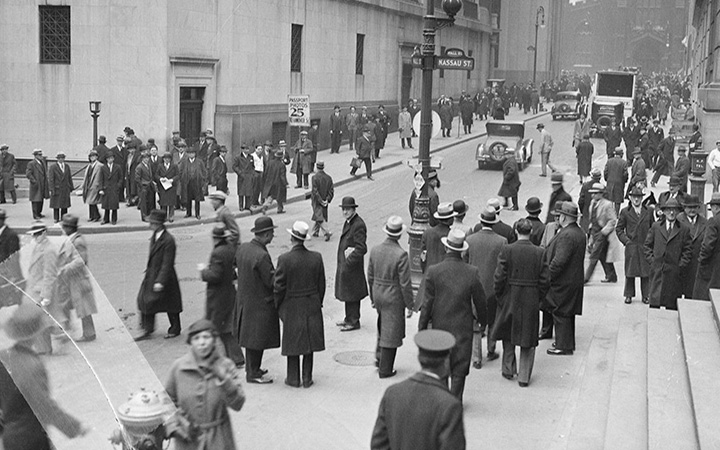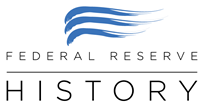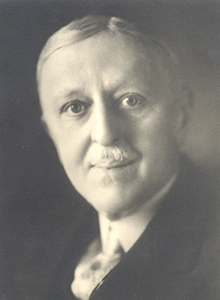Bank Holiday of 1933
March 1933

At 1:00 a.m. on Monday, March 6, President Roosevelt issued Proclamation 2039 ordering the suspension of all banking transactions, effective immediately. He had taken the oath of office only thirty-six hours earlier.
The terms of the presidential proclamation specified that "no such banking institution or branch shall pay out, export, earmark, or permit the withdrawal or transfer in any manner or by any device whatsoever, of any gold or silver coin or bullion or currency or take any other action which might facilitate the hoarding thereof; nor shall any such banking institution or branch pay out deposits, make loans or discounts, deal in foreign exchange, transfer credits from the United States to any place abroad, or transact any other banking business whatsoever."
For an entire week, Americans would have no access to banks or banking services. They could not withdraw or transfer their money, nor could they make deposits.
The crisis had been a long time coming. In the three years leading up to it thousands of banks had failed. But a new round of problems that began in early 1933 placed a severe strain on New York banks, many of which held balances for banks in other parts of the country.
George L. Harrison, head of the Federal Reserve Bank of New York, and Federal Reserve Board Governor Eugene Meyer were pivotal figures in the bank holiday. On March 1, 1933, Harrison sent an urgent message to Meyer and Secretary of the Treasury Ogden Mills: The New York Reserve Bank's gold reserve had fallen below the legal limit (Eccles 1982, 84-85).
Reserve Banks were required to maintain gold reserves equal to 40 percent of the paper currency they issued, but foreign and domestic holders of US currency were rapidly losing faith in paper money and were redeeming dollars at an alarming rate (Wheelock 1992, 19). Harrison's communique to Washington bluntly stated that he would "no longer take responsibility" for running the New York Reserve Bank "with deficient reserves" (Eccles 1982, 85).
When the Federal Reserve Board responded that it was reluctantly considering a thirty-day suspension of the legal gold reserve requirements, Harrison pointed out that a suspension of the requirements would not stem the outflow of gold. In his view, the best course would be to declare a national bank holiday that "would permit the country to calm down and allow time for the enactment of remedial legislation" (Burns 1974, 36-37).
But the initiative in declaring a bank holiday could only come from President Hoover, who was refusing to meet with Treasury Secretary Mills and Governor Meyer.
The pair [Mills and Meyer] on being blocked at the White House door, returned to Harrison with a suggestion that he ask Herbert Lehman, who had succeeded President-elect Franklin D. Roosevelt as governor of New York, to declare a bank holiday in that state. Harrison rejected the suggestion, saying that even if Lehman agreed to the request, the New York Federal Reserve Bank would still have to pay out gold to foreigners. Besides, to halt all banking operations in New York, the nation's financial center, would make it impossible for the banking system to function in the rest of the United States (Eccles 1982, 85).
A number of New York's most prominent bankers also opposed a statewide bank holiday on the grounds that it would hurt their prestige. In a meeting with New York Governor Lehman, they declared they "would rather stay open and take their beating" (Eccles 1982, 85).
By March 3, however, the mounting toll of bank closures and failures had forced bankers and their regulators to recognize the need for decisive action. The directors of the Federal Reserve Bank of New York adopted a resolution requesting that the Federal Reserve Board urge President Hoover to proclaim a nationwide bank holiday.
The New York Fed's Harrison reversed his opposition to a statewide bank holiday, and representatives of the Clearing House Banks of New York followed with a qualified endorsement of the proposal (provided the record show they neither sought nor directly requested the action) (Eccles 1982, 85). On the following day, Saturday, March 4, all twelve Federal Reserve Banks kept their doors locked, and banks in thirty-seven states either closed completely or operated under state-imposed restrictions on withdrawals.
All that remained was for the president to order a nationwide bank holiday, but neither President Hoover nor President-elect Roosevelt appeared willing to take the next step. Roosevelt's advisers, who had no clearly defined strategy of their own for dealing with the banking crisis, seemed content to remain vague until their boss moved into the White House.
Expectations ran high on March 4, 1933, as Franklin D. Roosevelt stepped to the podium to deliver his inaugural address. Although the address was short on specifics, Roosevelt identified two immediate objectives: getting people back to work and "strict supervision of all banking and credits and investments" (Roosevelt 1933).
The following day, cabinet members joined with Treasury and Federal Reserve officials to lay the groundwork for a national bank holiday, and at 1:00 a.m. on Monday, March 6, President Roosevelt issued a proclamation ordering the suspension of all banking transactions, effective immediately. It was based on drafts originally prepared for President Hoover by Treasury and Federal Reserve Board officials (Burns 1974, 42). The nationwide bank holiday was to extend through Thursday, March 9, at which time Congress would convene in extraordinary session to consider emergency legislation aimed at restoring public confidence in the financial system. Meanwhile, everyone else tried to deal with the reality that all banks were to remain closed until further notice. People had no way of knowing when, or if, they would ever see their money again. Yet, for the most part, there was surprisingly little panic. An article in the Boston Post noted:
"Everybody seemed to take the bank closings with good nature. Police officers on duty at the banks with instructions to inform any prospective depositors just why they could not leave their money reported that there was little or no excitement because the doors of the bank were not open. There seemed to be few who appeared for the purpose of withdrawing cash, the officers said, and many thought it was a great joke that they were unable to get into the banks for the purpose of making deposits" (Federal Reserve Bank of Boston 1999, 20).
According to an Associated Press report:
"The average citizen's chief trouble appeared to lie in difficulty of cashing paychecks. Stores generally extended credit more liberally for household necessities. ... Money orders were generally limited to $100. One company paid 25 percent for incoming money orders and gave checks for the balances. Railroad companies took emergency action, announcing broadened credit and stating that travelers would not be left stranded anywhere because of banking difficulties" (Federal Reserve Bank of Boston 1999, 20).
Across America, people did their best to cope with the bank closings. Milwaukee ministers agreed not to pass collection plates until the crisis was over, and the First Baptist Church in El Paso, Texas, arranged to accept I.O.U.'s (Federal Reserve Bank of Boston 1999, 20). Pushcart peddlers in Boston wouldn't hand over their fruits and vegetables to customers who tried to pay with large bills (11). In Bronx Traffic Court "28 law violators served one-day sentences rather than pay out their cash for fines of $2 to $5" (16). An ad for Pebeco Tooth Paste declared that "To back our faith in the current emergency program, we stand ready to keep millions of American families supplied with tooth paste. ... Get three tubes. Take three months to pay" (25). The governor of California gave a reprieve to condemned murderer Peter Farrington because of the "doubtful legality of hanging on a holiday" (26). There was, however, no reprieve for those who owed federal income tax. The IRS was perfectly willing to accept checks (13).
Back in Washington, government officials and congressional leaders continued to grapple with the task of reopening the banks. One of their greatest challenges was finding a way to prevent reopened banks from failing. They accomplished this by hammering out a proposal to reopen banks in stages.1 Class A banks were solvent institutions in little or no danger of failing. Class B banks were endangered, weakened, or insolvent institutions that were thought to be capable of reopening after an indefinite period of reorganization. Class C banks were insolvent institutions that would not be allowed to reopen. "The Federal Reserve Banks," writes Allan Meltzer (2003), "sent the Treasury lists of banks recommended for reopening, and the Treasury licensed those it approved." Congress would eventually incorporate much of this proposal into the Emergency Banking Act (Meltzer 2003, 422).
But before banks could reopen, there also needed to be agreement on whether or not to "weaken the link between gold and note issue" (Meltzer 2003, 423). At one point, Treasury officials seriously considered issuing large amounts of government scrip as an emergency substitute to take the place of cash. They even went so far as to print $10 million worth, but in the end Treasury Secretary William Woodin backed away from the plan, primarily out of concern that the public would not accept scrip at face value. "Where would we be," Woodin wondered aloud, "if we had I.O.U.'s, scrip, and certificates floating all around the country" (Federal Reserve Bank of Boston 1999, 20).
Instead he decided to "issue currency against the sound assets of the banks [as opposed to issuing currency against gold]. The Federal Reserve Act lets us print all we'll need. And it won't frighten the people. It won't look like stage money. It'll be money that looks like real money" (Federal Reserve Bank of Boston 1999, 20).
The Federal Reserve would have greater authority to support banks that reopened by lending "more freely" against the sound assets of those banks. In George Harrison's view, the Federal Reserve Banks would "become in effect guarantors of the deposits of reopened banks" (Meltzer 2003, 423).
The crisis began to subside on March 9, when Congress passed the Emergency Banking Act. On March 13, only four days after the emergency legislation went into effect, member banks in Federal Reserve cities received permission to reopen. By March 15, banks controlling 90 percent of the country's banking resources had resumed operations and deposits far exceeded withdrawals. Although some 4,000 banks would remain closed forever and full economic recovery was still years in the future, the worst of the banking crisis seemed to be over.
Endnotes
- 1 A compelling account of the crisis and a discussion of how the Fed helped to reopen the banks can be found in the Annual Report of the Federal Reserve Board for 1933. Pages 3 to 25 discuss the crisis. Page 14 in particular focuses on the reopening of banks. The report is available online here: https://fraser.stlouisfed.org/title/117/item/2491.
Bibliography
Burns, Helen M. The American Banking Community and the New Deal Banking Reform, 1933-1935. Westport: Greenwood Press, 1974.
Eccles George S. The Politics of Banking. Salt Lake City: University of Utah Press, 1982.
Federal Reserve Bank of Boston. "Closed for the Holiday: The Bank Holiday of 1933." January 1, 1999. Available on FRASER.
Federal Reserve Board. "Twentieth Annual Report of the Federal Reserve Board for 1933." 1934, Available on FRASER.
Meltzer, Allan H. A History of the Federal Reserve. Volume 1, 1913-1951. Chicago: University of Chicago Press, 2003.
Roosevelt, Franklin D. "Inaugural Address," March 4, 1933. Online by Gerhard Peters and John T. Woolley, The American Presidency Project. https://www.presidency.ucsb.edu/documents/inaugural-address-8.
Roosevelt, Franklin D. "Proclamation 2039 - Declaring Bank Holiday," March 6, 1933. Online by Gerhard Peters and John T. Woolley, The American Presidency Project. https://www.presidency.ucsb.edu/documents/proclamation-2039-bank-holiday-march-6-9-1933-inclusive.
Time. "The Presidency: The Roosevelt Week." March 13, 1933.
Wheelock, David C. "Monetary Policy in the Great Depression: What the Fed Did, and Why," Federal Reserve Bank of St. Louis Review, March/April 1992, 19. https://doi.org/10.20955/r.74.3-28 Available on FRASER.
Written as of November 22, 2013. See disclaimer and update policy.




 X
X  facebook
facebook
 email
email